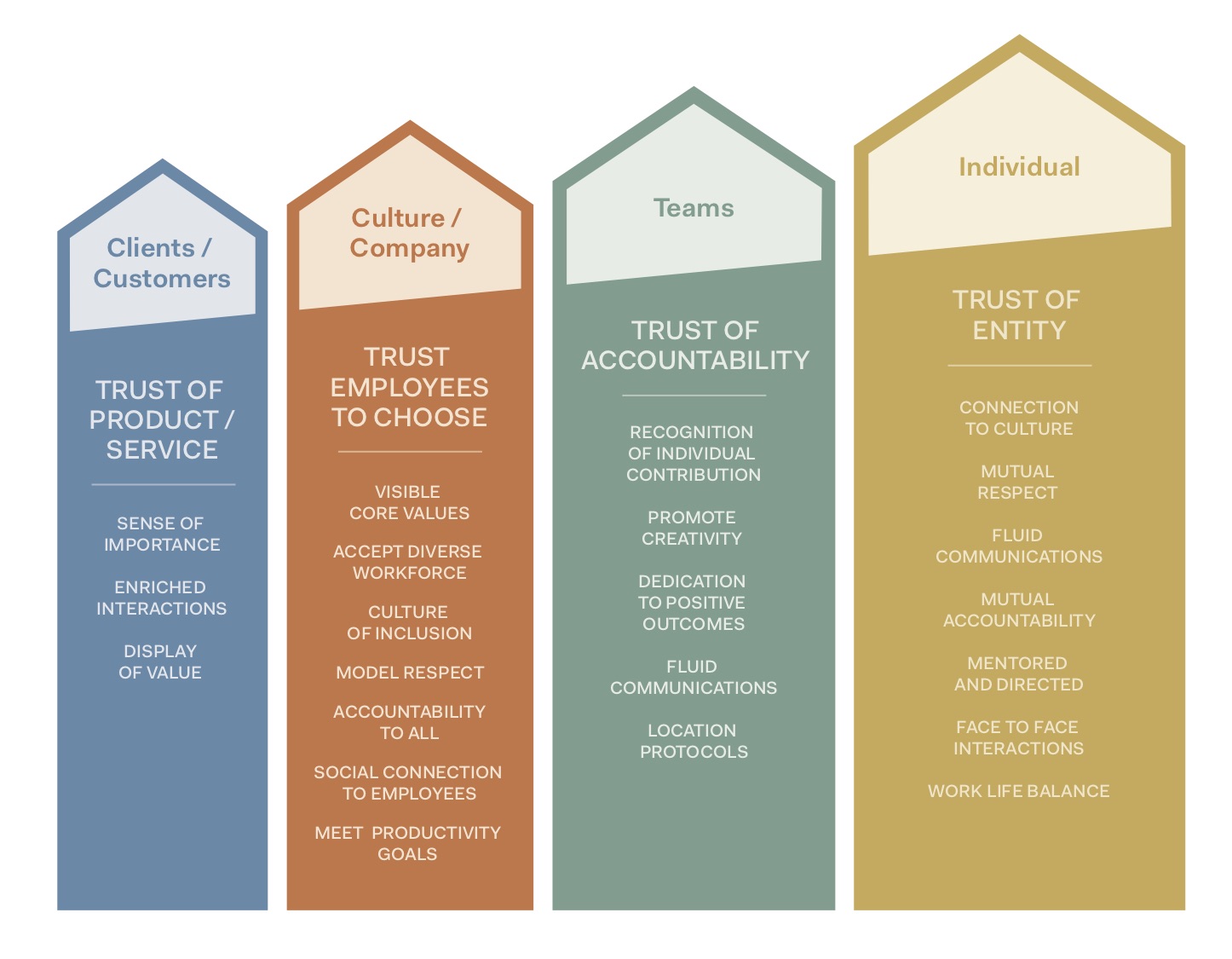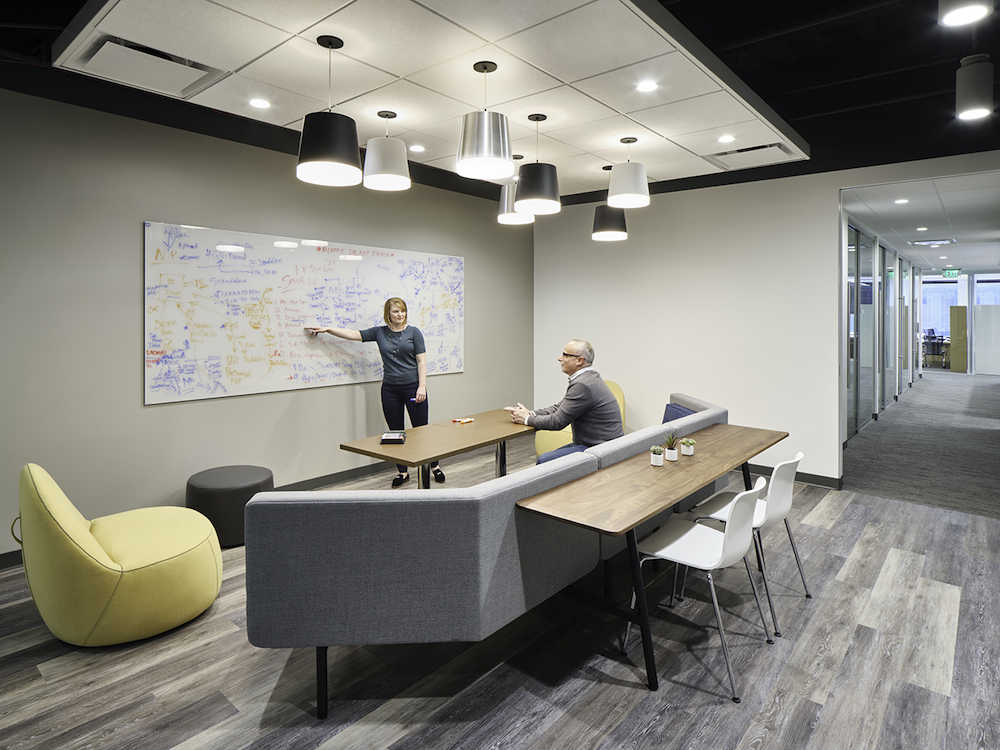Francis Cauffman Architects‘ Ann Hoffman shares the four pillars of transformation management to help better understand and prepare for the return to the office.

As we look towards a return to the office, design strategists and leaders have been absorbing every bit of information, searching for answers regarding what is next for the workplace. While abundant surveys, research studies, and projections have saturated the industry, there is no “crystal ball” for designers. Researchers and end-users have landed on the term “hybrid” for the next office with no prescriptive definition of what that looks like. The design of the future office is dependent on each organization’s unique culture, philosophy, and group experience in the remote working period.
Regardless of industry, company size, or subject matter, organizations can turn to a four-pillar framework to construct their new hybrid model. Just as change management helps employees acclimate to a new work environment, transformation management helps employees and leadership transition into the office. Transformation management allows strategists, designers, and company leadership alike to make thoughtful policies, and structure that offers choice without losing sight of the company’s focus and mission. Acknowledging these priorities and needs maintains a company mission, productivity, and services while addressing the acceleration of choice for individuals. Balancing support from the four pillars provides an understanding of these priorities in a myriad of questions, promoting employee happiness and maintaining business productivity.
Transformation management allows strategists, designers, and company leadership alike to make thoughtful policies, and structure that offers choice without losing sight of the company’s focus and mission
How do we make the shift from a demand on “presence in the office” to a choice environment that still meets the needs of the organization and its critical members? Trust is the foundation of the hybrid working model, replacing the mandates for compliance. Do we trust our employees to do the work when they are not in our sight? Do employees trust that leadership will consider and reward them appropriately even if they are not working in the office? There is a great adjustment period ahead and understanding what is now important can help guide the process. The data and analysis that strategists use to form their interiors is not there. It may take at least a number of months or even a year to see, and these new standards may still be evolving after that. In the meantime, as we readjust and readapt to new practices, the four pillars guide us to satisfy priorities. Our society is forever changed, we are not the same people as we were in March of 2020, and we must recognize that in our behaviors that ultimately translate to design.
To better understand and prepare for the return to the office, it is important to consider the below pillars that form transformation management:

Pillar One: Clients
As we emerge from the pandemic, companies need to reaffirm the trust between themselves and their customers and create ways to express their value. We have transitioned to a blended and virtual environment, and as a result, expectations for interactions have changed. The norm of in-person meetings changed to virtual – how can we continue this without deteriorating a relationship? What can your company offer to enrich the experience either through physical meetings or upgraded technology? Building new experiences into the environment to reconnect your work to the mission will go a long way in solidifying that relationship.
Pillar Two: Company and Culture
Trust is the catalyst for company culture. Working from home was mandated, but now, after we have been re-wired, how do we operate a WFH culture that fosters mutual trust? Working from home has been successful because we traded on the culture that was built in the office before we left. How do we solidify a bond with a dispersed workforce, particularly those who have joined an organization during the pandemic? What touchpoints do we build into our work schedules that allow us to form a working bond? How do we meet the employees’ shifted expectations and still solidify our culture?
The role of the physical office has changed to be more of a flagbearer for all that the company believes in and stands for. The office should now more than before be a visualization for the brand. Exemplifying the values in the use of materials, office settings can begin offerings of healthy foods and accommodations made for diversity and inclusion. We experienced all those things without hesitation in our homes and are now expecting them to be part of the office.
This solution is two-fold, as businesses must not only make changes to their working model but also make physical changes to the office to support these new working styles (such as video conferencing spaces and equipment, a variety of seating from lounges and group seating to breakout rooms and traditional desking). The seemingly minor details of an office can no longer be overlooked––what types of coffee/tea are offered? Are there snacks or healthy lunch options? Is fitness a priority? Are there walking paths nearby or a gym membership provided as part of employee benefits? The pandemic shifted employee expectations because it was in their control whether they took a walk midday, joined a virtual yoga session at lunch, became coffee fanatics, or food gurus. These individual changes will impact company culture expectations. As a result, employers must address how an office can shift to ensure employees feel that their mental and physical well-being and overall workplace happiness are being prioritized.

Pillar Three: Teams
This pillar explores the structure, communication, and collaboration for teams, specifically in a post-pandemic society. Companies need to reflect on what has changed about the way teams communicate. It is crucial to consider how the hybrid model works and what adjustments need to be made in the office to support both remote and in-office teamwork in tandem.
Essential to the work is the mutual trust among team members to be accountable to each other. Just like before the pandemic, communication is the key, only now we must revisit communication protocols on so many platforms.
Collaboration settings, promoted for over 20 years but not fully embraced by some, is now pivotal to the physical office. It is the top reason for people to come into the office and it must be worth the time it takes to commute, or people will choose not to come. A physical environment for collaboration will always outperform virtual platforms. Natural conversations, physical cues in body language and response have been missed through the virtual sessions in the pandemic. Nimble environments that keep tasks and people fluid in their adaptation will go a long way to creating an elevated experience in collaboration. Drawing people to the office for collaboration is a major contributor to building team trust and ultimately the culture.
Teams are instrumental in driving the new ways to work. Taking note of their behaviors will give insight into the way employees will choose to work together. It would be insightful to allow them to “hack” their current spaces while in the office to get a glimpse of how configurations and postures can change to suit the new ways people work together.

Pillar Four: Individuals
The individual pillar is about establishing a work-life balance and ensuring employee well-being takes priority in the workplace. As we slowly venture into our offices, there will be new phases of adjustment and anxiety. Surviving and thriving in this year of uncertainty has made us different people and workers. Our expectations have been shifted, and our skills challenged, and in most cases, expanded. Some have lost precious time with leaders and mentors the same way children who left school for home learning are missing the enriched experience of being in a classroom with their teachers.
While we can certainly see a brighter future ahead that allows us to return to our offices without hesitancy, we have to recognize that we will have the occurrence of new behaviors and expectations as we return. As we would assign change management implementation to acclimate to a new workplace, we should be considering transformation management for returning employees to the office.
Conclusion
How do we measure and predict the upcoming months and years of office behaviors? We are in the next workplace revolution and when it comes to physical space it’s an evolution. We have to throw away our surveys and data that is pre-pandemic and look to structuring a new model of hybrid work, wherever that lands. First and foremost, we have to create a purpose for people to come to the office. Once there, we must leverage the mission, the brand, the culture, the values and human capital for the highest performance. Building a framework for those spaces and policies goes a long way to establishing the goals. For all this to work, we start with a foundation of trust and inclusion. We have learned that much for sure.

